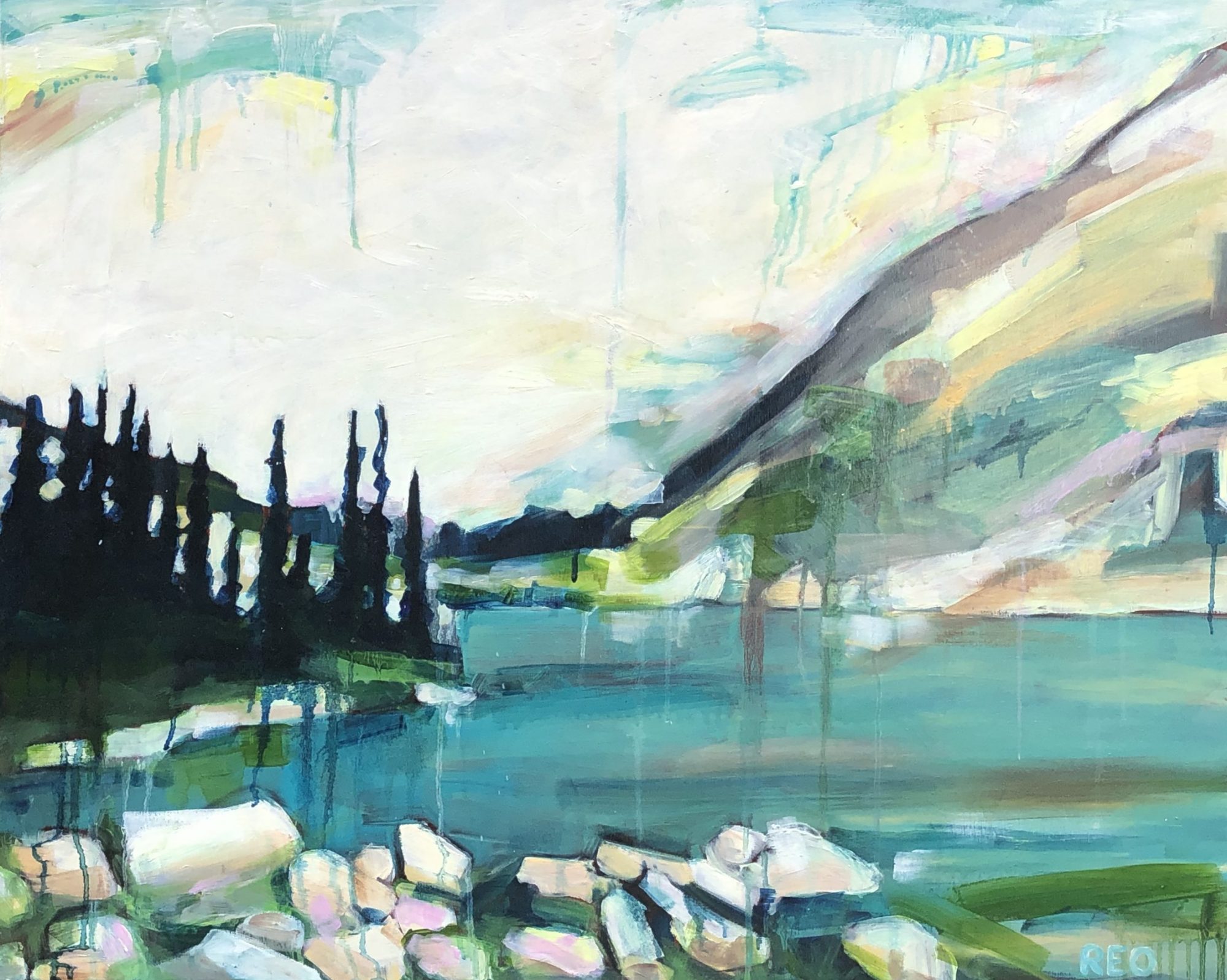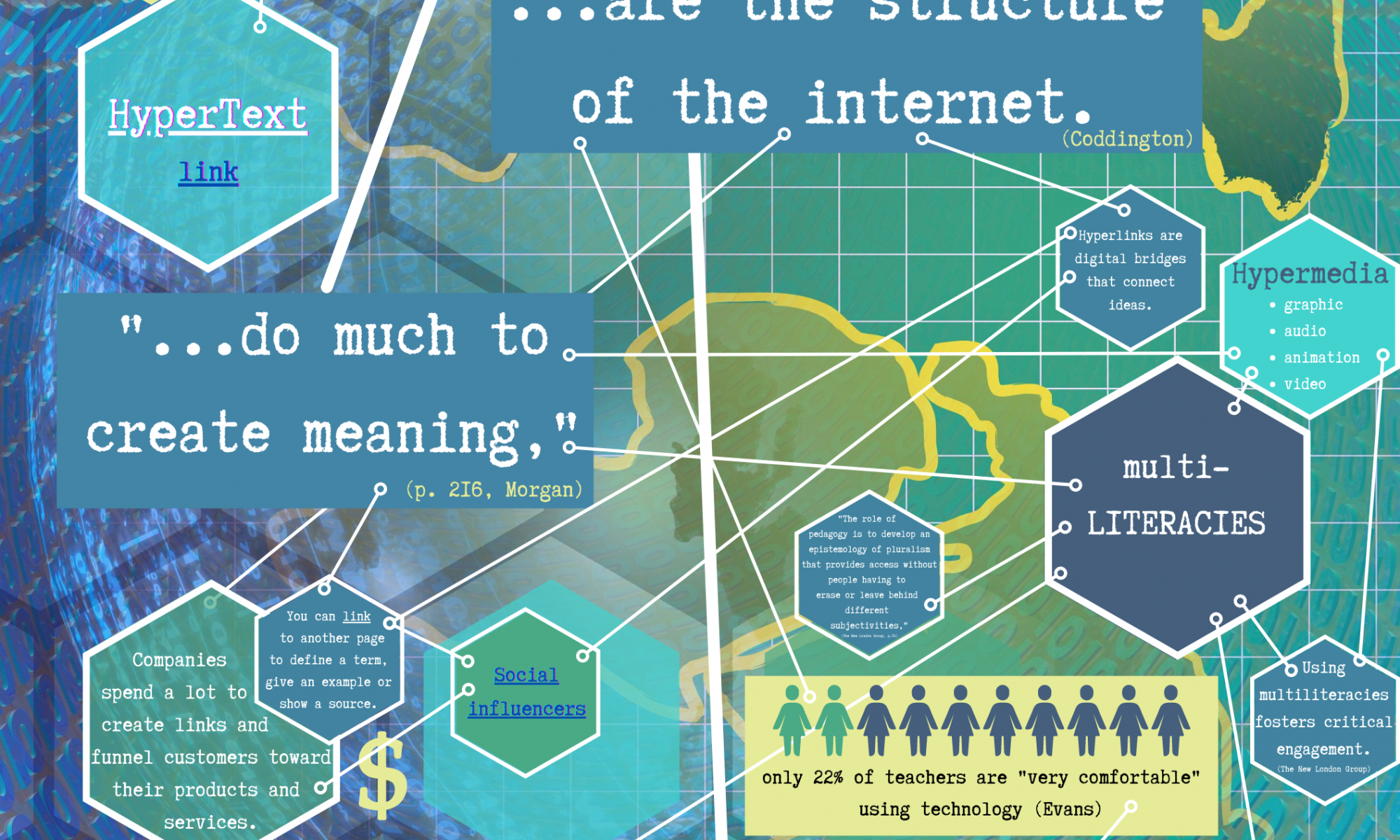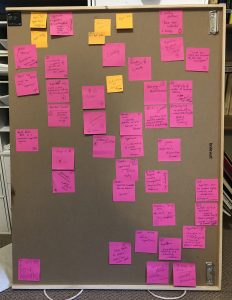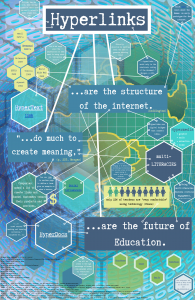Task #12 – Speculative Narratives
2051 : A speculative narrative about the future of the “Hyperlink”
The gradual, but steady increase of light from my window gently nudges me from sleep as the tint morphs from my preferred night time shade to the standard purplish hue of the UV 500 protection glass. As I sit up, stretching and twisting my neck to the side to release a bit of stiffness, I notice that I have messages waiting, but nothing marked as urgent. They can wait until I am more alert and ready to connect with others.
I luxuriate in the morning stillness, not wanting to break the silence. Then I quickly inhale and wince a little as I recall that I have an early class today and cannot afford to dally. I move swiftly into the shower, activating my internal sound implants (ISI’s) with a firm tap behind my right ear as I place my multi-interface glasses across my nose . I start sifting through the messages that have accumulated during my sleep, smiling wryly as I see yet another midnight missive from one of my nocturnal students. Tye isn’t really nocturnal, but seems to do most of their learning while I am sleeping. I skip to this message immediately, as Tye is often the first to notice broken or stolen data links within our learner interface.
With a quick eye swipe and a blink, I select this message and it plays in my preferred Augmented Reality (AR) style setting. I enjoy seeing the students’ avatars imposed into my home, like little cartoon sprites. Whether they are strangely dry as I shampoo my hair (like this morning) or standing in my cup of tea, these holographic figures help to make me feel connected to the students that I have never, physically, shared a space with. In this brief message, complete with artificially imposed gestures, Tye alerts me to the latest hijacking of our course content and my mind wanders again to Tye’s identity.
Like so many of my students, Tye has kept their gender, their location, their appearance and likely even their voice to themselves. The data is stored somewhere, but our government has become so protective of its citizens, that very few could have access to it. Where once identity was thought to be key to forming relationships and enhancing learning, we are now well aware that one’s personal information can be easily mined for profit and true equality exists only in anonymity. All humans are susceptible to biases and it will take many generations of imposed global equality to remove thousands of years of practice.
As I move from the shower to my closet, I orate and send a quick note back to Tye, assuring them that I have received the message and will repair the link. I use my regular voice and my default avatar. While everyone is in hiding, I’ve decided that the best way to stay hidden is in plain sight. My avatar looks exactly like me, sounds exactly like me and visits places around the world that I have always wanted to see. It is so obviously me, that authorities would think it an obvious fabrication or deem me completely naive.
After dressing, I set up a cup of tea to steep in the kitchen area and turn towards the large wall that separates my apartment from the adjacent one. I really am quite indifferent about tea, but need this time built into my daily routine. My private work wall is the same as the others in my small living area, the only exception being that it is not externally visible at any angle, through any window. It is adorned with a large and simple abstract painting, painted by me, that is comprised of subtle colour transitions from top to bottom and side to side. It is strikingly calm as the colours are almost identical in value. In fact, to a truly colour blind individual, it would appear to be a completely solid or singular shade.
Here, in this spot, I remove my MI glasses, gently massage my nose and put on the plain looking sunglasses that were sitting next to my wide brim hat and UV gloves on the counter. I pick up the cup of tea, blow across the top of it and gently press my right index finger to the rim of my sunglasses to activate the hidden visual projection feature. The painting now glows like an antique, backlit computer screen and I again appreciate how far technology has evolved in my relatively short and, as yet, insignificant life span.
To think, people were once connected around the world, with just a simple click of a button. My mom would tell me stories about handheld, miniature computers that even children could use and walk around with. How wifi and bluetooth connections were common place and free, and all the continents were digitally linked. It wasn’t perfect. Children were stalked, cyber crimes persisted and identities were stolen. There was even a “dark web” that connected criminals and Facebook was used to create social connections, to help people stay in touch with each other. It sounds so alien from the reality of today.
I am conscious of the time. I load the Canadian Learning Interface (CLI), log in with the ghosted M.I. glasses that are designed to mimic the government algorithms. With a few simple gestures I remove the external link that I so carefully installed the evening before, sign out and resign myself to trying again next week.
Most instructors would love to have a student like Tye. I, however, wonder again about their identity. It can’t be a coincidence that they are always the first to come across the renegade links, can it? Last semester, my carefully crafted links enriched the learning of dozens of students. Hopefully, mentally liberating them from our country’s circuitous and politically stale feedback loop.
As I sip on the hot tea, which fogs my sunglasses, I think about how it has been almost 25 years since the destruction of the dark web. An event which was followed by seven years of progressively less ethical and legal ability to govern the world wide web as societies focused their resources on reacting to the increasing number environmental disasters and sicknesses that plagued our globe.
I remove the sunglasses, place them gently back on the counter, finish the hot tea and put the government issued MI glasses back onto my face, where they relink instantly to the ISI’s. I leisurely amble from behind my kitchen peninsula to the middle of the living room. I stop in the well worn spot where the violet-tinted sun beams warm the floor beneath my feet as I switch the glasses to full VR (virtual reality) mode and prepare to greet my students as they arrive. This morning’s seminar is a lesson on how to mix and blend images and colours and imbed educational information into images to facilitate deeper learning challenges for the 21st century student.
The images are predominantly stock images, and the data is prescreened and pre-approved. My students will be able to upload their own images, should they choose to give up the ownership of them, but they will not be able to create their own data sets, nor can they link to any data outside of Canada. Given the constraints, I genuinely question the CLI’s use of the term deeper. It has been seventeen years since the various countries assumed the governance of the internet activities of their citizens and fifteen years since the disconnection of all the major transcontinental network cables.
I wiggle my bare toes in the sun, and press them deeper into the soft filaments that curl from the top of my neural network mat, yet another perk of working in education. I gently exhale as my students begin to materialize in my space. I have set today’s lesson in Norman Rockwell’s studio, as depicted by the artist in his numerous self-portraits. I secretly smile to myself as I enjoy the subversive contrast of teaching a highly censored curriculum in the creative space of a long dead human rights activist.
The clock flicks to 7 am in the exact moment that Tye arrives. All are there. “Good morning, class,” I begin.
______________________________________________________
Tye leans back in her chair. Her avatars are in place and currently viewable in dozens of different classrooms and in equally as many forms. This algorithm is her best yet and she has been amazed with how quickly it has learned to sort data, create personas and study the patterns of the instructors. She knows she is close to a breakthrough; she has been patient and was again rewarded with the discovery of an external link last night.
Perhaps today she will be able to trace it backwards through the software? There must be a digital footprint, a way to connect it to the rebels. Tye yawns, and manually adjusts the setting that keeps the algorithm on time. Someone might be suspicious if it is too much like clock work. With a satisfied stretch she rises to make herself a cup of tea, mentally preparing for another long day of sorting through data and shoring up leaks.
_______________________________________________________
The narrative above feels like it expanded and grew as I typed. It is far longer than I intended and I’ve dedicated so much time to the research parts already that I am hesitant to start my second narrative. Instead I will write briefly about the premise.
My second imagined or alternate future of the hyperlink is based on the expansion of the link to aid in moving to a paperless society. This is a future with high density living and vast expanses of forests and farmland. With knowledge at our fingertips and the ability to link to targeted learning, scholars and elders, we no longer repeat the same mistakes. Technology and AI evolve to be so accurately predictive, that catastrophic events are avoidable and the focus has shifted to the healing of our planet and the betterment of all humans.
Task #10 – Attention Economy
Bagaar’s online game User Inyerface
First attempt:
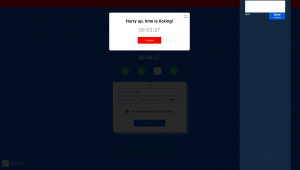
This was a very annoying activity. This is how far I got into it with a six year old bugging me to explain what I was doing and interrupting me because she wanted to play. I quit here, took a screen shot, and decided to return to the activity when I had more time and less distractions.
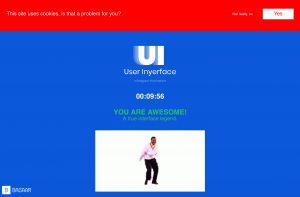
Here is my screen shot from this evening (my previous attempt was a couple days ago). I was able to close the door on my studio/office and focus on following the directions posted on the screen. I had gathered from my previous start to this assignment, and from the readings this week, that it would be important to read carefully, rather than scan the pages. The running timer made me feel like I needed to be going faster, as did the text at the beginning that instructed me to go as quickly as possible. This inevitably caused me to miss some obvious instructions and make me feel as though I wasted a lot of time – especially when repeatedly checking the boxes in the last exercise, as it took me a couple tries to realize that I needed to scroll up to select them all.
This gamification, through use of a timer and moving through tasks, reminded me of how Tristan Harris talked about the, “…race for our attention,” in his TED talk (2017). Bagaar’s use of the recurring pop-up timer perfectly illustrated Harris’ explanation of how notifications schedule our thoughts. I was able to forget about the timer, read instructions and make headway; then that timer would pop back up, my heart would race and I would have to close it before returning to the ongoing and seemingly unrelated task.
The other place in this game where I felt that I ‘lost time’ was simply that it was about entering my personal data. I have many autofill options saved into my computer, but with Dr. Tufekci’s TED talk (2017) fresh in my mind, I was feeling hyper-vigilant about not putting my exact details in. In fact, she so clearly explained persuasion architecture that I am much more nervous about the learning algorithms that have already collected my personal data and I’m worried about what, beyond marketing, that it will be used for in the future. How often are my political views manipulated? How much weight do I give opinions that are shared by my “friends”?
And, most importantly, how might I use what I have learned this week about notifications scheduling thoughts to benefit the students in my classroom?
References
Harris, T. (2017). How a handful of tech companies control billions of minds every day. Retrieved from https://www.ted.com/talks/tristan_harris_the_manipulative_tricks_tech_companies_use_to_capture_your_attention?language=en
Tufekci, Z. (2017). We’re building a dystopia just to make people click on ads. Retrieved from https://www.ted.com/talks/zeynep_tufekci_we_re_building_a_dystopia_just_to_make_people_click_on_ads?language=en (Links to an external site.)
Task #9 – Data Analysis
Here are some of the ways I looked at and organized the data on my first evening with it.

I liked seeing us broken into groups of like-minded people. This data sort made me think about how a social network platform might group us to sell our data to different marketers.
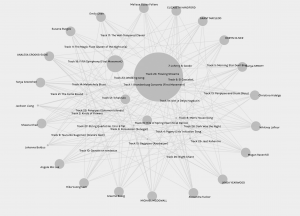
This particular visual is my favourite for looking at the actual choices and is visually more appealing than a simple bar graph or list, in that you can see the individual choices as well. It is a surprising amount of data in one image.
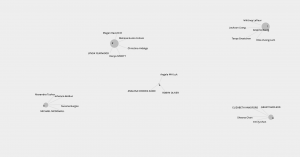
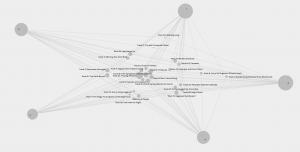
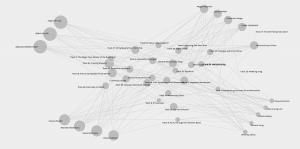
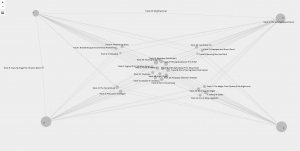
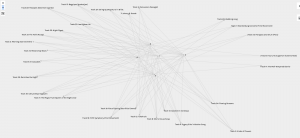

I used this list above, with a highlighter on a paper copy, to track the top the picks and who most consistently picked what the ‘group’ chose. In this way, I see that Elizabeth Hanford and Megan Ravenhill might be the best “social influencers” in our class, as they connected with the most people – in terms of strengths of their interests.
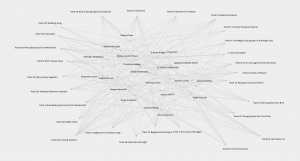
I have enjoyed this week’s task, in that I could dive into the networked web of data that was produced and see how the commonalities created “weight” for our selections and that these could be interpreted as trends. I can easily understand how my own personal data is collected and sold to advertisers and I better understand the power of ‘social influencers‘ in our society. Along this note, I have become more frustrated with advertising and located some other articles to read.
Niu et al. discuss the invasiveness of social media advertising (SMA) and note that, “Individuals engage in social media mainly to support their social interactions with others, but the appearance of SMA interrupts those goal-directed behaviors” (p. 4). The annoyance felt by the consumer can alter their perceptions of the products advertised, even though they may be the perfect audience and would normally have bought the products or services. This is where I sit most of the time and increasingly turn away from social media in my frustrated mindset. I wonder where the pendulum will swing next? Perhaps a renewed interest in paying for a platform or game to avoid the ads? Will Facebook change an annual fee for ad-free use?
Reference
Niu, X., Wang, X., & Liu, Z. (01/01/2021). When I feel invaded, I will avoid it: The effect of advertising invasiveness on consumers’ avoidance of social media advertising Elsevier. doi:10.1016/j.jretconser.2020.102320
Task #8 – Golden Record Curation
THE LIST…
- Bach, Brandenburg Concerto No. 2 in F. First Movement, Munich Bach Orchestra, Karl Richter, conductor. 4:40
- Java, court gamelan, “Kinds of Flowers,” recorded by Robert Brown. 4:43
- ? African – Senegal, percussion, recorded by Charles Duvelle. 2:08
- Congo rainforests – Zaire, Pygmy girls’ initiation song, recorded by Colin Turnbull. 0:56
- ?Australia, Aborigine songs, “Morning Star” and “Devil Bird,” recorded by Sandra LeBrun Holmes. 1:26
- Mexico, “El Cascabel,” performed by Lorenzo Barcelata and the Mariachi México. 3:14
- ? Rock n roll “Johnny B. Goode,” written and performed by Chuck Berry. 2:38
- ? New Guinea, men’s house song, recorded by Robert MacLennan. 1:20
- ? Japan, shakuhachi, “Tsuru No Sugomori” (“Crane’s Nest,”) performed by Goro Yamaguchi. 4:51
- Bach, “Gavotte en rondeaux” from the Partita No. 3 in E major for Violin, performed by Arthur Grumiaux. 2:55
- ? Classical – Mozart, The Magic Flute, Queen of the Night aria, no. 14. Edda Moser, soprano. Bavarian State Opera, Munich, Wolfgang Sawallisch, conductor. 2:55
- Georgian S.S.R., chorus, “Tchakrulo,” collected by Radio Moscow. 2:18
- Peru, panpipes and drum, collected by Casa de la Cultura, Lima. 0:52
- ? “Melancholy Blues,” performed by Louis Armstrong and his Hot Seven. 3:05
- Azerbaijan S.S.R., bagpipes, recorded by Radio Moscow. 2:30
- 1913 – Stravinsky, Rite of Spring, Sacrificial Dance, Columbia Symphony Orchestra, Igor Stravinsky, conductor. 4:35
- Bach, The Well-Tempered Clavier, Book 2, Prelude and Fugue in C, No.1. Glenn Gould, piano. 4:48
- Beethoven, Fifth Symphony, First Movement, the Philharmonia Orchestra, Otto Klemperer, conductor. 7:20
- ?? Bulgaria, “Izlel je Delyo Hagdutin,” sung by Valya Balkanska. 4:59
- Navajo Indians, Night Chant, recorded by Willard Rhodes. 0:57
- Holborne, Paueans, Galliards, Almains and Other Short Aeirs, “The Fairie Round,” performed by David Munrow and the Early Music Consort of London. 1:17
- ? Solomon Islands, panpipes, collected by the Solomon Islands Broadcasting Service. 1:12
- Peru, wedding song, recorded by John Cohen. 0:38 – singing
- ?China, ch’in, “Flowing Streams,” performed by Kuan P’ing-hu. 7:37
- India, raga, “Jaat Kahan Ho,” sung by Surshri Kesar Bai Kerkar. 3:30
- “Dark Was the Night,” written and performed by Blind Willie Johnson. 3:15
- Beethoven, String Quartet No. 13 in B flat, Opus 130, Cavatina, performed by Budapest String Quartet. 6:37
This is a difficult task and one that I have struggled with. I sincerely want an equal representation of music from around the globe, but am very aware of wanting to cancel out items that do not appeal to my auditory aesthetics. I suspect this is the same issue with the original committee, though I also found the list very limiting. For example, there is no Celtic/Irish music.
The list of 27 songs seemed to be very ‘populist authoritarian’ in its creation, so I began by eliminating a lot of Beethoven/Bach pieces. I then liked the idea of choosing pieces that included voices, and eventually settled on the bolded songs above.
_____________________________________________________________________
“Populist authoritarianism can best be explained as a cultural backlash in Western societies against long-term, ongoing social change.”
“This long-term generational shift threatens many traditionalists’ cultural values. Less educated and older citizens fear becoming marginalized and left behind within their own countries.”
Task #7 – Multimodal Design
In revisiting our first task from this course, I have been reflecting upon our public and private lives and our use of social media. So much of what we choose to put out there and what creates our digital footprints and personas is a privately curated assortment of images, thoughts, sounds and feelings. I liken this selection process to choosing one’s wardrobe. On Ellie Brown’s website, as I look back to our first task, this is the reason that she included photos of the people whose bag contents were displayed. In examining the literal baggage that people carry around with them, we are invited into some of the more private aspects of their lives.
Some people will create “ghost” accounts on social media so that they can be anonymous voyeurs of the actions and thoughts of others. Or, like me, they may be very careful in their selections of what they feel is appropriate to put out to the world. Perhaps what I DON’T post is much more indicative of my true self, and obviously more private, and may be as interesting of a journey as Camille Thoman and Ellie Brown’s BAG project was.
For this week’s task, I am looking to recontextualize, to, “…shap[e] emergent meaning” (p. 75, The New London Group), the images on my cell phone. I am hoping to create a video that shows my self-editing process and is akin to the activity of baring my private baggage, completed six weeks ago.
_______
My video is too large to upload here. I have posted it to YouTube.
I quite like this new app and am glad that I have added it to my digital tech tool box. I think taking a viewer on a trip through all of the apps on my phone might be like emptying my digital pockets, baring my private stuff and perhaps illustrate how much time I waste on other, less productive, tools!
Maybe an idea for another task.
The New London Group. (1996). A pedagogy of multiliteracies: Designing social futures. (Links to an external site.) Harvard Educational Review 66(1), 60-92.
Task #6 – Emojis :$
Wow! This was a tricky task. – Thank you for a thought provoking week!

Emoji Book Summary (this is a link to a PDF)
“The main point is that the relationship between word and image is becoming unstable” (Bolter, p.49).
Bolter discusses at length how the relationship between words and images is tenuous and constantly shifting. I was quite inclined to agree with him about the power of the visual image, being a visual artist myself, but having worked on this week’s tasks for hours and finding no sense of success has really changed my thinking.
While films have much power and cultural importance (p. 57, Bolter), I would argue that images without language haven’t the same weight and that pictures and words will be interdependent for years to come. Emoji’s have a place in sending messages and adding tone, but I was unable to string together any real sentences or detailed descriptions. In trying to summarize the latest book that I read, I found that I had to keep removing details that I felt were important to the characters and the story line. Now, I have a brief summary of what could be any ‘whodunnit?’ style of mystery.
In short, using generic images resulted in a generic plot. Though this seems obvious to me now, I needed to complete the task to truly understand what Bolton meant when he wrote, “…picture writing lacks narrative power” (p. 59). I am relating this back to a self portrait project that I am working on with my senior Art students this week and next, where they use Typography or written words to create the value ranges in their images. We discuss how a simple portrait describes what they look like and the words they use describes who they are. These can be quite powerful when completed. Another timely art lesson!
Chapter 4. Bolter, J. D. (2001). Writing space: Computers, hypertext, and the remediation of print (2nd ed.). Mahwah, N.J: Lawrence Erlbaum Associates. doi:10.4324/9781410600110
Task #5 – Twine & Hypertext
Day one – Here is some pre-Twine reflection and research that I have done based on my questions. I read some interesting discussion posts about adding ‘agency’ to the decision making in Twine to create games, rather than stories. I wonder if it really turns the narrative into a true game, or if it is just a way of making the story reading process more fun? I’m not sure where to draw the line on my thoughts here, but perhaps it will become more clear once I begin using Twine and see how this unfolds.
I recommend this article by Emily Short.
And now to try and create a game-like? story in Twine….
Day two – I am five hours in, on evening number two, and am learning now that “hot-linking’ images is a bad thing to do. I will now try to find instructions to host images elsewhere? I’m VERY new to coding and this is quite complex! Also, it is almost my bedtime 🙁
Day three – I stayed up way past my bedtime last night and got quite frustrated. Tonight has gone better. I have been saving images into my UBC blog media files – but music in mp3 format still won’t save there. I have now created 8 pages in Twine, learned how to host and resize images. I have changed backgrounds, added buttons, created links and am next wanting to create hypertext that links out of the story/game. I will save this for tomorrow; it is bedtime.
Day four and five – I finally feel like I am making some real headway! I can now link out of the site and have created 20 pages! I have changed text colours, enchanted a word to make it float and have been adding pictures with ease. 
I like the way the story web is shaping up and wonder about using this Software to create a very in-depth Family Tree, where you could link directly to people who are living and collect digital artifacts for those who are not. This could be quite cool!
I’ve finished my twine-based pottery story/lesson. I didn’t succeed in creating “Agency”, but I have learned a lot and revisited a movie that I haven’t seen in years. I chose to base this around a movie theme to help add engagement. I chose pottery as my starting point as it seemed best to start with a least one thing that I know!
Finally, I really appreciated the Hypertext reading this week. When I was in elementary school (in the mid to late 80’s), I was part of a “gifted” program and had the opportunity to work with one of the earliest Hypercard programs. I wasn’t able to create nearly the level of connections with it that I just completed in Twine, but I did work with a partner to make a digital ‘choose your own adventure’ style of story in grade five and remember how fun that had been and how special we had felt. There were only the two computers that we could access and they were on a bus that travelled between schools in our small rural district…
“Although in a printed book it would be intolerably pedantic to write footnotes, in the computer we have already come to regard this layered writing and reading as natural.” (p 27, Bolter).
Bolter, Jay David. (2001). Writing space: computers, hypertext, and the remediation of print. New York, NY: Routledge.
Task #4 – Potato Prints!
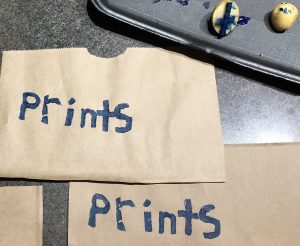
I opted for this task because I had just finished digging all the potatoes out of my garden, so it seemed like a sign, and I am just moving into a printmaking project with my grade 8/9 Drawing and Painting class of 30 students this next week. With my background in Art, I have taken relief printing classes at a university level and regularly teach screen printing and lino cut printing at my Secondary School. I could not, however, recall the last time I tried potato printing, so was keen to do something fun and playful.
To challenge myself, I did not pre-draw the letters on to the potatoes and I didn’t worry about matching the sizes of the potatoes that I selected from my drawer. I used acrylic paint for my ‘ink’ and printed onto the paper grocery bag scraps that I had left over from wrapping a birthday present. I like the way that the thick pthalo blue paint looks on the recycled and reused brown paper.
I worked quickly and had this completed in about 10 minutes. Most of that time was spent cutting the potatoes, and I smiled a bit to myself as I realized that many students would create their letter stamps backwards. It is something I always warn my students about, if they are designing a project with words in it.
I really enjoy making things by hand and truly appreciate the time I spend weaving, crocheting, painting, throwing pottery and sewing. This added value of handmade items is part of what drives my creativity. I love the personal touch and the variety within the prints. However, there is no way that I would want to create an entire book using this method of printing and I am thankful that I can reflect upon my printing process by typing out this sentence on my MacBook . ????
Thank you to Johannes Gutenberg for inventing the printing press and thank you to artisans like Paul Collier who help to keep some of the older technologies alive and working so that we can fully understand the advancements over time.
Task #3 – Voice to Text
For this assignment, I decided to try the dictation app that is embedded in Microsoft Office 365. I use voice to text when giving students feedback on their artwork every week by using an iPad in my classroom. When doing this, I usually speak slower and voice my punctuation. For this exercise, today, I opted to simply tell the story and not watch the screen as I spoke. I know that this slows me down at work, but that I need to catch and fix all of the errors.
Here is what I have:
One of the strangest things about this assignment is how long it has taken me to decide what to talk about I’ve gone back and forth for days and it has to do with how permanent it is when you put something into writing I think I was thinking that whatever story I decided to tell for the next few minutes needed to be important enough to be written or funny or entertaining and finally I just went back to at one point in one of the readings the the idea that a picture is worth 1000 words so that’s why I decided to start I have gone back through some of my photos and decided on this one cute little photo that I came across of my daughter how my took it three years ago now so she’s six at the moment and she was three when I took this picture and we had gone down to a little pond locali here down near the lake and it stocked every year with these little fish little trout minnows and the kids love just to throw some bits of cracker and bread into the pond and the fish eat it there’s some turtles that come over anwyl Neville on the bread as well it’s just a very cute place to take kids and it’s fun for them and we were down there this one day and we had her little bucket and a net so as the fish were coming and eating all the little bits of cracker that she was throwing in she was catching a few fish and taking them from the net and putting them into the bucket and having a lot of fun and looking at the fish and then we’re getting close to the time where we have to put the fish back in the pond ’cause we had to leave and she was feeling kind of sad about having to put the fish back because she had three of these little fish in her bucket so I showed her about how to have you could pick one up and then put it back in the lake and of course what does she start doing but as she picks up each of these cute little fish she gives it a kiss and then puts it back into the pond so I when she went to do the last fish from her bucket and I by then had gotten out my phone and use the camera to get a little picture and a video of her kissing the fish and going to put it back and then in the in the video it when she went to kiss it to go and put it back she the fish slipped out of her hands and went back into the bucket and she giggled and said something about how does such a wiggly little one and then I did get a photo of her kissing the fish after she caught it again in the bucket and was going to put it into the lake so it was just this really cute thing that she was doing where she didn’t even think about how stinky the fish were or how bad or hands smelt later and that she just needed to kiss each fish before she sent it on its way and now I’m wondering if she would consider kissing a fish so perhaps this afternoon when I’m done my homework I could take her down to the pond with some crackers and maybe we’ll catch some fish for her bucket and I’ll see if she has any interest in kissing them like she used to.
____________________________________________________________
In doing this exercise, I am not surprised about it being a jumbled mess of a run-on sentence. In reading and re-reading it, I find that I am still hearing my voice say the words and, because they are my words, I am mentally pausing at all of the appropriate places that punctuation would go. I don’t really see any of this passage as being ‘wrong’ or ‘right’ as I went into it expecting to get a very flawed piece of writing. There are fewer errors than I get with the iPad dictations that I do at work. I suspect that MS Office is more accurately predictive in choosing ‘witch’ ???? words I am using based upon the context of the words surrounding them. The mistakes, besides the glaring lack of punctuation, are mostly a result of my poor enunciation of words, for example the word ‘her’ is typed as ‘or’ and I must have mumbled the, “…and nibbled on the bread,”as it reads, “…anwyl Neville on the bread.”
I see also that my talking was repetitive, especially when I added details to clarify or describe. I find it much slower to read my words without the punctuation and am looking forward to seeing how this exercise has gone for some of my peers. All of my pauses are not recorded, so this seems much quicker than the five minutes that I took to record the story. It is the lack of space between the words that bothers me the most, and it is not just the space for breathing that is created by a comma or period. I am quite aware of the power of a pause in Storytelling and understand how much meaning can be lost by removing inflection, tone and space from the words. In removing the orator (myself) from the story, you cannot tell where I smiled or giggled.
Any public speaking that I have done has been scripted. I feel the need to write the words and practice what I want to say in order to get my thoughts straight. I draw calmness and comfort from this practice time and scripting ; public speaking is not fun for me and dictating the above story to post for this course gave me a similar kind of unease. I had not practiced and was oddly nervous and fidgety. I understand better how a storyteller will improve in years of telling the same stories. In seeing the reactions and adding inflection and emotion to their words. In oral storytelling, the orator or author is as important as the message. In a written story, the writer may be so far removed from the words that the reader is free to create their own meanings and add their own inflections and biases. I do not see that simply recording the words of a story will preserve all of the intended meaning. This concept is one that we discussed at length in ETEC 521 – Indigeneity, Technology & Education.
__________________________________________________________________
Notes for the future…
“Understanding 20th-century literacy means understanding the technologies that support it – since without the technologies, literate acts would be profoundly different.” (p. 17)
Haas, C. (2013). “The Technology Question.” In Writing technology: Studies on the materiality of literacy. Routledge. (pp. 3-23).
